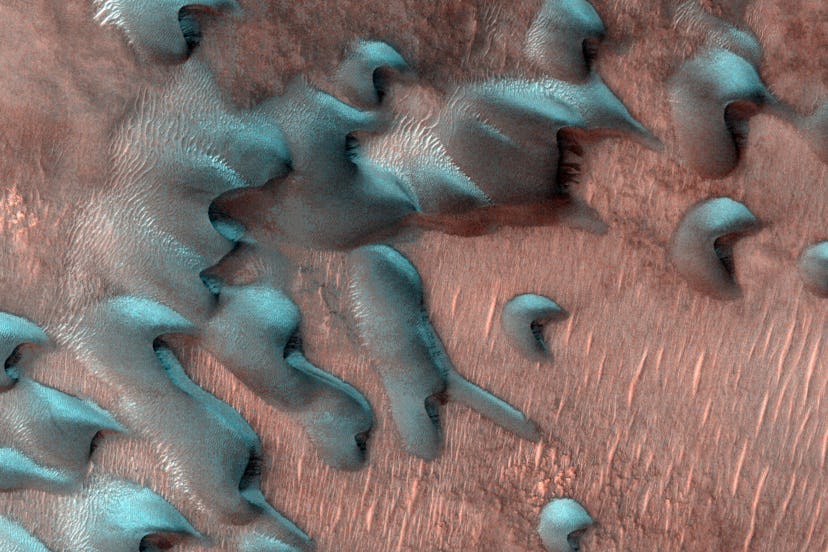5 Lessons From NASA’s Stunning New Images Of Winter On Mars
NASA shared several new photos of Mars showing how the planet’s red landscape is transformed during the winter months into areas of snow and ice.

When most of us think of the planet Mars, we think of varied landscapes covered with dry, red dirt. But new photos released by NASA remind us there’s way more to the Red Planet than that — including snow. And yes, it’s as glorious as any freshly fallen snow you’ll find our our blue marble. Pull up your kids and offer them a visual feast and a few weird and wild science lessons from the Red Planet.
On December 22, NASA shared several new photos taken by the robotic Mars explorers currently on the planet. The images show how the planet’s red landscape is transformed during the winter months into areas of snow and ice.
“When winter comes to Mars, the surface is transformed into a truly otherworldly holiday scene,” NASA writes. “Snow, ice, and frost accompany the season’s sub-zero temperatures. Some of the coldest of these occur at the planet’s poles, where it gets as low as minus 190 degrees Fahrenheit.”
Now, a new video from a major hub for NASA’s robotic explorer, known as the Jet Propulsion Laboratory in California, shows what wintertime looks like on Mars, including ice, frost, and snow.
Lesson #1: There are two kinds of ice on Mars.
NASA has found two different varieties of snow have been spotted on Mars: dry ice and water ice. The bulk of ice on Mars is dry, made out of carbon dioxide and found seasonlly on polar caps carbon dioxide. The water ice, on the other hand is frozen into thin layers on the poles that build up. It usually mixes with dust, giving the caps have bright and dark layers of "clean" and "dirty" ice.
Lesson #2: There are no snow or ice crystals on mars — it’s way weirder.
The snow and ice on Mars don’t look the same as the snow we see here on Earth. While we get flat snowflakes with intricate patterns on each flake, the snow on Mars is cube-shaped.
“Because carbon dioxide ice has a symmetry of four, we know dry-ice snowflakes would be cube-shaped,” Piqueux said. Using NASA’s Mars Reconnaissance Orbiter, which can see through cloud cover using its Mars Climate Sounder instrument, scientists know the snowflakes falling on Mars are tiny—“smaller than the width of a human hair,” Piqueux explains.
Lesson #4: The skiing’s (kjinda) good on Mars.
“Enough falls that you could snowshoe across it,” Sylvain Piqueux, a Mars scientist at NASA’s Jet Propulsion Laboratory, said, in a NASA release. “If you were looking for skiing, though, you’d have to go into a crater or cliffside, where snow could build up on a sloped surface.”
Lesson #5: The snow melt is as weird as the snow fall.
Scientists also could view what happens at the end of winter when the build-up of snow and ice begins to thaw. “As it does so, this ice takes on bizarre and beautiful shapes that have reminded scientists of spiders, Dalmatian spots, fried eggs, and Swiss cheese,” NASA writes.
Ice and snow don’t melt or thaw out the same way we see on Earth. “Translucent ice allows sunlight to heat up gas underneath it, and that gas eventually bursts out, sending fans of dust onto the surface,” NASA shares.
The new images are stunning, and the data the scientists will be able to learn from them are incredible, too. NASA hopes to observe how the ice thaws and what winter is like on the planet and will continue to answer questions on whether Mars could become a second home to humans in the future.
This article was originally published on